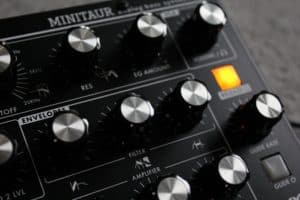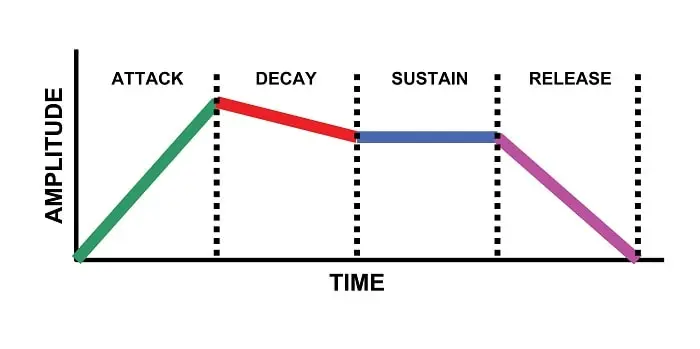 ADSR envelops became widespread with the invention of synths, and plays a major role in shaping the sound you get from these instruments. When you play any instrument, the sound it produces will have certain properties.
ADSR envelops became widespread with the invention of synths, and plays a major role in shaping the sound you get from these instruments. When you play any instrument, the sound it produces will have certain properties.
For example. when you play a note on an electric guitar, the volume will be the highest right after you pick the string, and it will rapidly die down. This property of the instrument is what ADSR envelopes were created to control.
Mechanical instruments such as pianos, guitars, violins and similar have a set nature of the tone. You can somewhat affect some of the properties, but the shape and mechanics of the instrument generally dictate what these properties will be, and how much you can change them. It wasn’t until the invention of synths that you finally had full control of attack sustain decay release parameters.
Overview
In modern synths, an ADSR envelope is a feature that allows you to automate certain parameters of the sound. It gives you complete control over things like pitch, timbre and volume.
There are four stages of an ADSR envelope – attack decay sustain release. Attack, decay and release are temporal parameters while sustain is a level parameter. Let’s take a closer look at each of these four stages and see what they do.

Attack
The attack stage of the ADSR envelope is the initial stage that dictates the time it takes for that particular sound to rise in volume from its minimum value to its maximum value. So when you play a note, attack stage will set the time it takes for the note to fade in to full volume.
If you set your attack to be long, you will get a slow fade in effect. If you set it to be short or non existent, the note will be played at maximum value as soon as you hit the key.
Decay
Decay is the next stage of the envelope. It comes into effect as soon as the attack reaches its peak. Once that happens, the decay will bring the volume down to the level of sustain.
Similar to attack stage, decay can also be very long, or almost non existent. If you set decay time to zero, you will hear a fade in from the attack stage, and a sudden drop to sustain level.
Sustain
Unlike the previous two stages, sustain is not a temporal parameter. What this means is that once you reach sustain stage, the volume of your note will remain the same as long as you are pressing down on the key.
This can last for a brief moment, or for an infinite amount of time. Sustain stage lasts until you let go of the key dedicated to the note you are playing at the moment. When that happens, release stage comes into play.
Release
Release stage is the last stage of the ADSR envelope. To recap what we know so far, as soon as you hit the key on your keyboard, you will activate a note.
At that moment the note you selected will start to fade in depending on the attack value you have selected. You are still holding the key down but the attack stage has passed and you are now in decay stage.
At this moment the volume of the note is dropping to the value of the sustain. how long that will take depends on the decay value you chose to use. As long as you are holding the key down, the sustain will play the note at a set volume.
You have released the key, and now release stage takes over. The note starts to fade out. Similar to attack and decay, the speed with which it will fade out depends on the length of the release stage.
Conclusion
Now that we know what attack sustain decay release envelopes do, we can apply some modulation. You can assign pitch or cutoff parameters to the envelope, which allows us to further shape the sound we want to get from a synth.
There mechanical and digital envelops out there, with the former being found in hardware synths, and latter in DAWs and similar software. ADSR envelopes are a powerful tool that has made a major impact on our understanding of music.

Interesting but, I have always known this as ASDR..